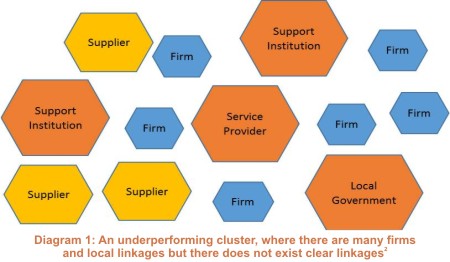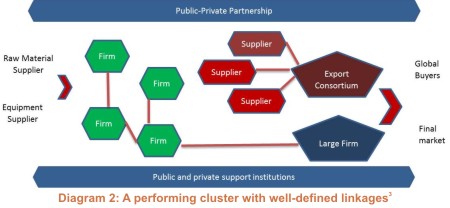|
Cluster Development -
Requirement
Global
Perspective
Indian Perspective With a contribution of 40% to the country's industrial output and 35% to direct exports, the Small-Scale Industry (SSI) sector has achieved significant milestones for the industrial development of India. Within the SSI sector, an important role is played by the numerous clusters that have been in existence for decades and sometimes even for centuries. According to a UNIDO survey of Indian SSI clusters undertaken in 1996 (later updated in 1998), there are 350 SSI clusters. Also, there are approximately 2000 rural and artisan based clusters in India. It is estimated that these clusters contribute 60% of the manufactured exports from India. The SSI clusters in India are estimated to have a significantly high share in employment generation.1
Defining Cluster A cluster is an agglomeration of small-scale industrial units. There are many dimensions to the apparently routine activities of a cluster. A cluster in itself is a thriving ecosystem-a network of interconnected organisations. There are forward and backward linkages, and then there are peripheral service providers, enhancing the productivity and ensuring quality of production of a particular cluster, such as designing support, testing laboratories, transporters, financial institutions, import agents etc. Geographical concentration of enterprises taking up similar activities is a prerequisite for existence of a cluster. Enterprises within clusters share many common features such as:
Besides enterprises, clusters also include support institutions, such as business associations, market aggregators, financial service providers, public authorities such as local, regional and national governments, regulatory agencies and academic institutions. However mere geographical agglomeration of enterprises cannot ensure high performance of a cluster. There are instances seen globally where the enterprises in clusters have faced cut-throat competition from one another. Furthermore, there have been stagnation and poverty, preventing clusters to reach their full potential. For taking the collective growth to the desired level, there has to be strong linkages between the players in the cluster ecosystem. The diagrams depict the difference between an underperforming cluster and a healthy cluster, having strong inter linkages. Clusters: Growth Drivers and Benefits The clusters in India are repository of traditional knowledge and skills involving several generations of people. There exist very unique skill sets, which are intrinsic asset of the clusters. Some of these clusters get formed and succeed because of access to pooled labour market of the skilled workers in the region. Another critical factor which defines growth of a cluster is abundant availability of raw materials. The role of regional government is also critical as it often played significant roles in providing seed for formation and development of the clusters. The benefits MSME units reap from cluster formation are multifold. It has the power of reviving a local economy or pushing an existing system into a higher trajectory of performance. Economies of scale are developed, reducing cost of production. Greater synergies are established between enterprises and support institutions. Development of markets becomes a core activity – export and e- commerce channels are explored and market intelligence becomes easily accessible. Due to technology and market interventions in the clusters, often new products are developed fetching higher value, the sales volume increase, skill set of the workers are enhanced and accessing finance becomes easier. Negative impact of manufacturing activities on the environment can be minimised by combined initiatives like setting up common effluent treatment plants for wastewater treatment, or a common waste recycling facility. Policy Initiatives in India In independent India, government and policy makers have taken keen interest in development of clusters. Developing a cluster is a long-term assignment. There is also need for developing common resources and when gains are elicited from the established common resources, there is need for its distribution; all of which require involvement of a central agency which would have the authority to perform the function of facilitator – thus state interventions came naturally to cluster development. There are multiple institutions who have been playing catalytic role in cluster development in India such as Department of MSME, Government of India; National Small Industrial Corporation Limited; Ministry of Textile; Ministry of Science and Technology. Then there are state governments working in their respective geographical territories and national support institutions such as SIDBI, NABARD and State Bank of India. However, it was only in 2002-03 that cluster development programmes (CDPs), especially in traditional manufacturing, gathered noticeable momentum at the national level, with lead taken by the Ministry of MSME and the introduction of the Small Industries Cluster Development Programme (SICDP) scheme. The Scheme was later renamed as Micro and Small Enterprise Cluster Development Programme (MSECDP), in the year 2006. The Ministry has also launched a cluster development programme for household (khadi and village industries) enterprises called the Scheme of Fund for Regeneration of Traditional Industries (SFURTI) and has also initiated a MSME support scheme called the National Manufacturing Competitiveness Programme (NMCP).4 Development Alternatives and Cluster based Work In its journey of 36 years, significant work had been undertaken by the Development Alternative (DA) Group in cluster-based work. DA has been following a value chain development approach, which comprises of technology upgradation and extension, value addition-based enterprise development and market access and extension. It has been working on cluster pertaining to the following sectors:
IMEDF, the social enterprise development vehicle of the Development Alternatives Group, is an empanelled Nodal Agency under the Scheme for Fund for Regeneration of Traditional Industries (SFURTI) Programme with the Ministry of MSME. IMEDF as the Nodal Agency is responsible for identification of clusters, selection of Implementation Agency (IA), having capacity of ground level development of the cluster, and appointment of Technical Agency (TA). The effort is to transform traditional village industry into clusters of excellence. Cluster based Approach: Future For sustainable and inclusive economy, wholistic cluster development approach will be the multiplication engine. It will be the catalyst for enterprise development and will provide a conducive ecosystem for their sustenance. The focus will need to be on unexplored sectors and geographies. For instance, there exist huge scope of work in agriculture sector as around 72% of India’s vegetable and fruit produce gets wasted. Farm level aggregation, sorting, storage, value addition can add millions of rupees in income of the farmers and pull out many from the grasp of poverty. There will be a ripple effect, centred around the cluster which will have the potential of transforming the local and national economy. ■
Poulami Datta
References: |

